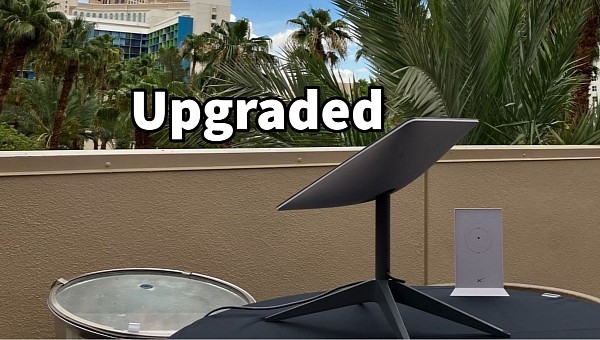SpaceX has accelerated its satellite launch program, and it has more than 4,000 satellites in orbit. This helped ease the Starlink network congestion in some areas. Thanks to the increased capacity, SpaceX is now upgrading early Best Effort customers to the Residential tier.
Satellite internet services are nothing new, although until SpaceX launched Starlink, this type of connection was slow and very expensive. Elon Musk’s internet service relies on low-Earth-orbit (LEO) satellites to offer improved connection speed for a fraction of the price of existing satellite services. With Starlink, people were thrilled to finally get a reliable internet connection in remote areas without alternatives. But they soon discovered that popularity is not the best feature of an internet service.
As more people signed up for Starlink, some areas got crowded, and the connection quality dropped. Eventually, SpaceX offered new customers a “best-effort” service, where they had to compete for resources with other customers. The connection speed was also limited to 5-50 Mbps, but SpaceX promised to upgrade those customers to full-speed plans in 2023. Many customers that were on a waitlist since 2021, mostly in the southern U.S., accepted the new offer and were signed on the Best Effort plan in 2022. As the name implies, the speed and availability would be significantly degraded at times of traffic congestion.
Last week, the first Starlink Best Effort customers started receiving letters from SpaceX to inform them of changes in their subscription plan. As promised, SpaceX has automatically upgraded their plans from the Best Effort tier to the Residential tier, which allows connection speeds of up to 100 Mbps. The biggest improvement is in the minimum expected download speed, which increases from 5 Mbps to 20 Mbps. The first customers bumped into the Residential plan were in Ontario, Canada, but U.S. customers also received their letters in the following days.
In the letter it sent to customers, SpaceX says it can increase the connection speed thanks to introducing higher-performing satellites, a faster launch rate, and network optimization. The prices for the upgraded plan remain the same.
The company has started deploying the second-generation Starlink satellites, although things are not going according to plan. The 21 satellites from the first launch suffered technical problems, and Elon Musk said some of them might need to be deorbited. This will, no doubt, delay future V2 launches, although the first-generation satellites are still sent into orbit regularly.
SpaceX is also preparing to launch the fully-fledged Starlink V2 satellites as soon as it gets approval to operate the Starship. The V2 (non-Mini) satellites weigh around 2,000 kg (4,400 lbs.) compared to the 800-kg (1,800-lb) Starlink V2 Mini satellites, which explains why they cannot be launched on board the Falcon 9 rocket. SpaceX announced that it serves more than one million customers across 60 markets, and adding more capacity to its satellite constellation is its main priority. SpaceX has launched 495 satellites in this quarter alone.
As more people signed up for Starlink, some areas got crowded, and the connection quality dropped. Eventually, SpaceX offered new customers a “best-effort” service, where they had to compete for resources with other customers. The connection speed was also limited to 5-50 Mbps, but SpaceX promised to upgrade those customers to full-speed plans in 2023. Many customers that were on a waitlist since 2021, mostly in the southern U.S., accepted the new offer and were signed on the Best Effort plan in 2022. As the name implies, the speed and availability would be significantly degraded at times of traffic congestion.
Last week, the first Starlink Best Effort customers started receiving letters from SpaceX to inform them of changes in their subscription plan. As promised, SpaceX has automatically upgraded their plans from the Best Effort tier to the Residential tier, which allows connection speeds of up to 100 Mbps. The biggest improvement is in the minimum expected download speed, which increases from 5 Mbps to 20 Mbps. The first customers bumped into the Residential plan were in Ontario, Canada, but U.S. customers also received their letters in the following days.
In the letter it sent to customers, SpaceX says it can increase the connection speed thanks to introducing higher-performing satellites, a faster launch rate, and network optimization. The prices for the upgraded plan remain the same.
The company has started deploying the second-generation Starlink satellites, although things are not going according to plan. The 21 satellites from the first launch suffered technical problems, and Elon Musk said some of them might need to be deorbited. This will, no doubt, delay future V2 launches, although the first-generation satellites are still sent into orbit regularly.
SpaceX is also preparing to launch the fully-fledged Starlink V2 satellites as soon as it gets approval to operate the Starship. The V2 (non-Mini) satellites weigh around 2,000 kg (4,400 lbs.) compared to the 800-kg (1,800-lb) Starlink V2 Mini satellites, which explains why they cannot be launched on board the Falcon 9 rocket. SpaceX announced that it serves more than one million customers across 60 markets, and adding more capacity to its satellite constellation is its main priority. SpaceX has launched 495 satellites in this quarter alone.






